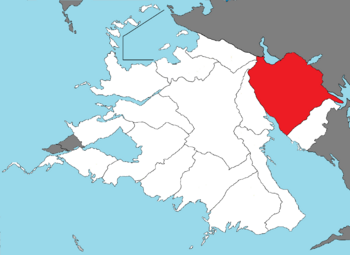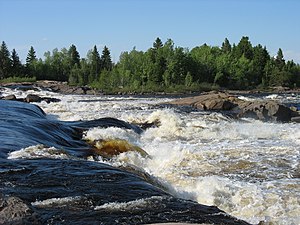Mayotte (Province): Difference between revisions
No edit summary |
|||
| Line 92: | Line 92: | ||
}} | }} | ||
'''Mayotte''' is an [[Administrative District (Zamastan)|Administrative District (Province)]] of [[Zamastan]]. The history of Mayotte spans thousands of years, with much of the [[Fifty Years War (Iearth)|Fifty Years War]] between the [[Drambenburg]]ian kingdoms and the [[Aunistria (Province)|Palatinate of Aunistria]] in the 1300s, the [[Parabocan War]] in the late 1800s, and sections of the [[World War (Iearth)|World War]] being fought in this province. While being a administrative region of Zamastan since the 1880s, Mayotte has long harbored nationalist and separatist sentiment, largely wishing independence or greater autonomy from the federal government. The election of [[President of Zamastan|President]] [[Atticus Moreau]], a member of the [[Bloc Mayotte (Zamastan)|Bloc Mayotte Party]], in 2020 boosted the hopes for independence. | '''Mayotte''' is an [[Administrative District (Zamastan)|Administrative District (Province)]] of [[Zamastan]]. The history of Mayotte spans thousands of years, with much of the [[Fifty Years War (Iearth)|Fifty Years War]] between the [[Drambenburg]]ian kingdoms and the [[Aunistria (Province)|Palatinate of Aunistria]] in the 1300s, the [[Parabocan War]] in the late 1800s, and sections of the [[World War (Iearth)|World War]] being fought in this province. While being a administrative region of Zamastan since the 1880s, Mayotte has long harbored nationalist and separatist sentiment, largely wishing independence or greater autonomy from the federal government. [[2020 Zamastan presidential election|The election]] of [[President of Zamastan|President]] [[Atticus Moreau]], a member of the [[Bloc Mayotte (Zamastan)|Bloc Mayotte Party]], in 2020 boosted the hopes for independence, while the [[Bettencourt Protests]] further drove those inspirations. | ||
[[Blythe]], the provincial capital of Mayotte, is also the largest city. Roughly 30% of the province's population is direct descendants of first or second generation immigrants, mostly [[Avergnon]]ian, Drambenburg, [[East Chanchajilla]], and [[Tinten]]. The province has a highly diversified economy, with major sectors including transportation, education, information technology and research, government services, and mining and a major tourist destination for outdoor recreation. Much of the population speaks [[wikipedia:French language|Avergnonian]] or [[wikipedia:German language|Drambenburgian]], making it alongside neighboring Aunistria the two largest populations of second-language speakers. | [[Blythe]], the provincial capital of Mayotte, is also the largest city. Roughly 30% of the province's population is direct descendants of first or second generation immigrants, mostly [[Avergnon]]ian, Drambenburg, [[East Chanchajilla]], and [[Tinten]]. The province has a highly diversified economy, with major sectors including transportation, education, information technology and research, government services, and mining and a major tourist destination for outdoor recreation. Much of the population speaks [[wikipedia:French language|Avergnonian]] or [[wikipedia:German language|Drambenburgian]], making it alongside neighboring Aunistria the two largest populations of second-language speakers. | ||
| Line 98: | Line 98: | ||
==History== | ==History== | ||
==Geography== | ==Geography== | ||
Located in the eastern part of Zamastan, and (from a historical and political perspective) part of Central [[Euronia]], Mayotte occupies a large territory, most of which is very sparsely populated. Its topography is very different from one region to another due to the varying composition of the ground, the climate (latitude and altitude), and the proximity to water. The Lawrence Lowland and the Louise Mountains are the two main topographic regions in western Mayotte, while the Aunistria Shield occupies most of central and eastern Mayotte. | |||
===Hydrography=== | |||
[[File:Chutes_à_Michel.jpg|thumb|left|Michel's falls on Ashuapmushuan River in Saint-Félicien, Saguenay–Lac-Saint-Jean]] | |||
Mayotte has one of the world's largest reserves of fresh water, occupying 12% of its surface. It has 3% of the world's renewable fresh water, whereas it has only 0.3% of its population. More than half a million lakes, including 30 with an area greater than 250 square kilometres (97 sq mi), and 4,500 rivers pour their torrents into the [[Toyana Ocean]], through the [[Bay of Titania]]. The largest inland body of water is [[Lake Louise]], although it is bordered and shared by [[East Chanchajilla]], [[West Chanchajilla]], and [[Gladysynthia]]. That makes [[Caniapiscau Lake]], created in the realization of the Titania Bay Project to produce hydroelectric power, the largest inland body of water located entirely in the province. [[Lake Sistassini]] is the largest natural lake in Mayotte | |||
The [[Jacquinot River]] has some of the world's largest sustaining inland Toyana Ocean ports at [[Livenneau]] and [[Pergrinau]]. Its access to the Toyana Ocean and the interior of Euronia a strategic place for the middle ages kingdoms and [[Drambenburg]]ian Empire and made it the base of early exploration and settlement in the 17th and 18th centuries. The river broadens into the world's largest estuary, the feeding site of numerous species of whales, fish, and seabirds. The river empties into the [[Bay of Titania]]. This marine environment sustains fisheries and smaller ports in the Lower Jacquinot and Gaspésie regions of the province. The Jacquinot River with its estuary forms the basis of Mayotte's development through the centuries. | |||
===Topography=== | |||
===Climate=== | |||
===Wildlife=== | |||
==Demographics== | ==Demographics== | ||
==Culture== | ==Culture== | ||
Revision as of 04:44, 29 October 2020
Mayotte | |
|---|---|
 Mayotte located in Zamastan | |
| Capital | Blythe |
| Government | |
• Governor | Thomas Braitwhite |
| Population | |
• Estimate | 27,132,000 |
Mayotte is an Administrative District (Province) of Zamastan. The history of Mayotte spans thousands of years, with much of the Fifty Years War between the Drambenburgian kingdoms and the Palatinate of Aunistria in the 1300s, the Parabocan War in the late 1800s, and sections of the World War being fought in this province. While being a administrative region of Zamastan since the 1880s, Mayotte has long harbored nationalist and separatist sentiment, largely wishing independence or greater autonomy from the federal government. The election of President Atticus Moreau, a member of the Bloc Mayotte Party, in 2020 boosted the hopes for independence, while the Bettencourt Protests further drove those inspirations.
Blythe, the provincial capital of Mayotte, is also the largest city. Roughly 30% of the province's population is direct descendants of first or second generation immigrants, mostly Avergnonian, Drambenburg, East Chanchajilla, and Tinten. The province has a highly diversified economy, with major sectors including transportation, education, information technology and research, government services, and mining and a major tourist destination for outdoor recreation. Much of the population speaks Avergnonian or Drambenburgian, making it alongside neighboring Aunistria the two largest populations of second-language speakers.
History
Geography
Located in the eastern part of Zamastan, and (from a historical and political perspective) part of Central Euronia, Mayotte occupies a large territory, most of which is very sparsely populated. Its topography is very different from one region to another due to the varying composition of the ground, the climate (latitude and altitude), and the proximity to water. The Lawrence Lowland and the Louise Mountains are the two main topographic regions in western Mayotte, while the Aunistria Shield occupies most of central and eastern Mayotte.
Hydrography
Mayotte has one of the world's largest reserves of fresh water, occupying 12% of its surface. It has 3% of the world's renewable fresh water, whereas it has only 0.3% of its population. More than half a million lakes, including 30 with an area greater than 250 square kilometres (97 sq mi), and 4,500 rivers pour their torrents into the Toyana Ocean, through the Bay of Titania. The largest inland body of water is Lake Louise, although it is bordered and shared by East Chanchajilla, West Chanchajilla, and Gladysynthia. That makes Caniapiscau Lake, created in the realization of the Titania Bay Project to produce hydroelectric power, the largest inland body of water located entirely in the province. Lake Sistassini is the largest natural lake in Mayotte
The Jacquinot River has some of the world's largest sustaining inland Toyana Ocean ports at Livenneau and Pergrinau. Its access to the Toyana Ocean and the interior of Euronia a strategic place for the middle ages kingdoms and Drambenburgian Empire and made it the base of early exploration and settlement in the 17th and 18th centuries. The river broadens into the world's largest estuary, the feeding site of numerous species of whales, fish, and seabirds. The river empties into the Bay of Titania. This marine environment sustains fisheries and smaller ports in the Lower Jacquinot and Gaspésie regions of the province. The Jacquinot River with its estuary forms the basis of Mayotte's development through the centuries.

